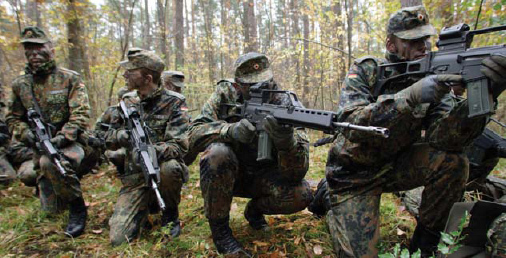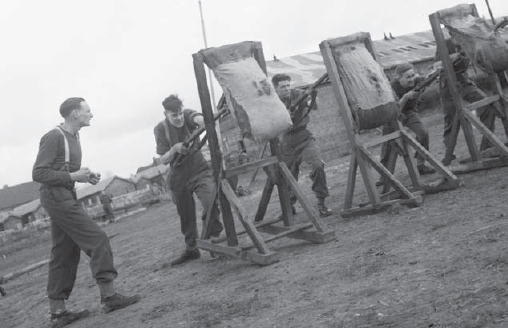Much more important than the happiness of left-handers is that when you want to fire round the corner of a building or other cover half the time you will need to fire left-handed to avoid exposing your body. It goes without saying that all soldiers must learn to shoot with either hand. So now you might see why I am so incensed that the British Army selected a weapon which physically cannot be fired from the left shoulder? Have these guys never been in a firefight? If so why are they making these decisions?

German soldiers with the Heckler & Koch G36. In my opinion this is marginally better than both the M16 and the AK47. (Topfoto)
To improve the rifle further would require a reduction in flash, noise, weight or ammunition supply and none of these are likely to be achieved so long as the rifle remains in anything like its current cartridge-fed, explosive-propelled, projectile-firing form. The next real generation of ‘rifle’, after the assault rifle, will probably be some form of beam or particle weapon. This could feasibly be silent and flash-free, thus overcoming the two major remaining drawbacks of the modern rifle. I have heard from a reliable source that the US is working on this.
Summary: What are the important things to remember about rifles?
I’ve talked on and on about rifles and their points for and against. The fact is you probably won’t get much of a choice in your rifle as long as you are a junior rank. What I want to get across to you is that all the rifles you are likely to see or use are pretty much all OK. They all weigh next to nothing and fire light ammunition very quickly, reliably and accurately. Keep your rifle clean, whatever it is, and it will serve you well. What you do need to consider is that it is best to use the same ammunition as everyone around you – in case you or they run short.
If I had to choose the Heckler & Koch G36/G36E is slightly better than either the M16 or the AK47, and probably demonstrates what the US Army is looking for to replace the Armalite, but is not on general issue.
Both the Armalite and the Kalashnikov are lovely weapons to use. But as a Special Forces operator I would suggest you favour a heavier, longer-range rifle in open country, an assault rifle for general use and possibly something even shorter for house clearing and Close Quarter Battle. But I still maintain that the most, indeed the only, important thing about a rifle is the man holding it.
BAYONETS
Goal: When is the right time to employ this weapon? What is it good for?
I hope you are never in a bayonet charge as it is an act of desperation in a modern conflict. The idea is to close with the enemy and, rather than shoot them from a distance, stab them to death with a long knife attached to the end of your rifle. Clearly this is a worrying prospect for anyone on the receiving end so one effect of a bayonet charge is to make the enemy break and run. About the only time to use a bayonet charge in modern times would be if your unit was running very low on ammunition and you were up against an enemy at very close quarters.

Bayonet practice, old school style. (IWM H18462)
I have been in two bayonet charges. To paraphrase the Duke of Wellington when talking about his own troops, ‘I don’t know what effect they had on the enemy but they scared the life out of me.’ Both charges were acts of desperation and in both the enemy got up and ran from positions where they could, and should, have cut us down before we got to them.
At one point we were patrolling from village to village somewhere in Africa. It was our job to go round to all the villages, show them we were friendly and try to get some information out of them about the movements of the terrorists who were living off them. Such ‘Hearts and Minds’ campaigns will sound familiar to Vietnam vets as well as soldiers in Afghanistan today.
In this countryside it was normal for a terrorist force to oblige the local population to feed the locals and to provide them with women. This meant the terrorists could operate freely without a supply line for food. If the villagers did not cooperate they were killed, horribly. If they gave any information away to the peacekeeping forces they were killed, horribly. A situation not too dissimilar to what is often experienced today in rural Afghanistan. We, as the defenders of democracy, were bound by our rules of engagement to be nice to the villagers. We just gave them medical aid and so forth. ‘Hearts and Minds’ as they say. Nichollo Machiavelli said words to the effect that if you can only have people love you or fear you then to fear you is best. And as a famous US officer or president – depending on who you believe – once said, ‘When you have them by the bollocks their hearts and minds will follow.’
If you were a villager would you toe the line set by the terrorists or would you help the ‘good guys’ and watch your family raped and tortured to death? In a war it is always the civilians who suffer the most and I could never blame the villagers for what happened next. Anyway, a stick* went into the village, two sticks stayed outside as per normal SOPs. When the talking was done it was the turn of my stick to go in and get some water. The first stick stayed in the village and the other stick stayed in cover outside.
As we left cover to walk towards the village, a distance off some 200 hundred yards across flat, bare, sloping ground, around 50 AK47s and a couple of RPD or PK machine guns opened up on us at a range of just 75 yards. The position for the ambush was perfect. We were caught out in the open with nowhere to go. Away from the fire was up hill with no cover. To either side was no cover for a hundred yards or more. Towards the enemy was no cover to the hedge-line they were hiding behind. In my own defence I must say that the village was surrounded by open space and that the approach I chose was the best of a bad job.
The ambush was perfectly constructed and the timing was exact. Had the opposition been able to shoot accurately we would have been dead in a couple of seconds. As it was we benefited from a feature of some of the opposition’s shooting technique. They lay down in position, pointed the rifle at you and then closed their eyes and looked at the ground while they were shooting. This was not typical of the trained African soldiers I had the pleasure of serving with. My friend Corporal Gosho (‘rat’ in Matabele) once dropped a moving target between the eyes, at over 100 yards, from a standing position in the bush. Thank God he was on our side.
The SOP for being ambushed is to charge the ambushers – as a properly constructed ambush should be inescapable and you should die quickly so, it could be said, this tactic gives you something to do while you are waiting. Amongst my team were a couple of Cockneys who had just left the French Foreign Legion Parachute Regiment and my good friend Yves Debay, who has no obvious concept of fear, so I could rely on them. Without thinking I gave the order to charge and we ran, line abreast at the enemy.
Commanding the other stick on our flank Corporal Ndlovu (‘elephant’ in Matabele) thought quickly enough to give us covering fire to help get the ambusher’s heads down. It was certainly his action that saved us. As it was, the sight of a bunch of crazy men running at you with bayonets fixed has a certain effect. Considerably more, I think, than rifles alone. The ambushers got up and ran for their lives. If I was a cat that would have been another life used up.
History: How did it develop to be the way it is?
Before the infantry had muskets they had spears (technically known as halberds and pikes) and the appropriate drills to use these effectively as a group. When muskets were first issued they had a very slow rate of fire of perhaps three rounds a minute on a good, dry day with well trained and steady men. If the enemy were approaching you quickly then there would come a time when they would stop you reloading. Likewise, if you were approaching the enemy and discharged your weapon you were left simply with a club.